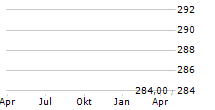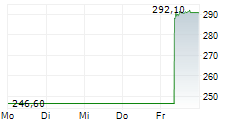- In AVONELLE-X, the largest long-term extension trial in nAMD, disease control and durability were maintained over 4 years, with nearly 80% of patients on extended dosing by study end1
- Over 60% of people with a difficult-to-treat form of nAMD showed no signs of damaging lesions in the SALWEEN study, and clinically meaningful vision improvements were observed2
- Vabysmo was well tolerated with a consistent long-term safety profile in nAMD in both studies
Basel, 05 September 2025 - Roche (SIX: RO, ROG; OTCQX: RHHBY) announced today new data from the AVONELLE-X and SALWEEN studies of Vabysmo® (faricimab),1,2 presented at the 25th Euretina Congress in Paris, France. Data from the open-label AVONELLE-X study reinforce the efficacy, safety and durability of Vabysmo over four years in neovascular or "wet" age-related macular degeneration (nAMD), a leading cause of vision loss.1 In the single-arm SALWEEN study, Vabysmo showed clinically meaningful vision gains and retinal drying over one year in polypoidal choroidal vasculopathy (PCV), a vision-threatening subtype of nAMD that is especially common in Asia.2
"The robust SALWEEN findings in PCV highlight Vabysmo's potential to deliver clinically meaningful improvements and help mitigate vision loss," said Levi Garraway, MD, PhD, Roche's chief medical officer and head of Global Product Development. "Alongside the long-term AVONELLE-X results in nAMD, these findings support our mission to develop and deliver impactful medicines for people with difficult-to-treat eye diseases."
In new one-year data from the single-arm, open-label Phase IIIb/IV SALWEEN study of Vabysmo for the treatment of people with PCV in Asia, patients experienced a clinically meaningful gain of 8.9 letters in best-corrected visual acuity (BCVA) from baseline averaged over weeks 40, 44 and 48.2 At year 1, more than 50% of patients were assigned to extended five-month dosing. Vabysmo also had a clinically meaningful impact on the abnormal, polyp-like blood vessels characteristic of PCV, with these lesions completely resolving in more than 60% of patients and inactivation of polypoidal lesions in the majority (86%) of eyes.2 Vabysmo was well tolerated, with a safety profile in PCV that was consistent with its known safety profile in nAMD.2
The AVONELLE-X study was a two-year open label extension of the two-year Phase III TENAYA and LUCERNE studies of Vabysmo in nAMD.1 Vision remained stable throughout the two years of AVONELLE-X and anatomic improvement from the parent trials were sustained through AVONELLE-X.1 Results showed that after up to four years of treatment with Vabysmo, nearly 80% of patients had extended their treatment intervals to every three or four months, reinforcing the results seen in TENAYA and LUCERNE. Vabysmo was well tolerated, and safety data were consistent with its known safety profile in nAMD.1
To date, Vabysmo is approved in more than 100 countries for nAMD and diabetic macular edema (DME), and in more than 60 countries for macular edema following retinal vein occlusion (RVO). More than eight million doses of Vabysmo have been distributed globally since its initial US approval in 2022.3-8
About neovascular age-related macular degeneration
Age-related macular degeneration (AMD) is a condition that affects the part of the eye that provides sharp, central vision needed for activities like reading. nAMD is an advanced form of the disease that can cause rapid and severe vision loss if left untreated.9-11 It develops when new and abnormal blood vessels grow uncontrolled under the macula, causing swelling, bleeding and/or fibrosis.11 Worldwide, around 20 million people are living with nAMD - the leading cause of vision loss in people over the age of 60 - and the condition will affect even more people around the world as the global population ages.9, 12-13
About polypoidal choroidal vasculopathy
Polypoidal choroidal vasculopathy (PCV) is a subtype of nAMD that is more prevalent in people of Asian or African descent than European descent. It accounts for up to 60% of nAMD cases in people of Asian descent, and up to 20% in people of European descent.14
PCV is characterised by abnormal blood vessels in the choroid, a thin layer of tissue between the sclera (the whites of the eyes) and the retina. These abnormal vessels can leak fluid or blood, leading to retinal damage and vision loss.14-16 People with PCV often experience blurred vision or a blind spot in or near the centre of their vision in one or both eyes.16,17 Early diagnosis and treatment are important to help restore vision and prevent further vision loss.15,18
About AVONELLE-X1
AVONELLE-X (NCT04777201) was an open label multicenter two-year extension study of Vabysmo in 1,029 patients with nAMD who completed one of the two Phase III studies, TENAYA(NCT03823287) or LUCERNE (NCT03823300).
Patients in TENAYA and LUCERNE were treated with either 6 mg Vabysmo or 2 mg aflibercept. During AVONELLE-X, all patients were treated with Vabysmo on a treat-and-extend regimen, where the time between Vabysmo treatments could be adjusted based on retinal fluid levels and visual acuity.
About SALWEEN2
SALWEEN was a Phase IIIb/IV multicentre, open-label, single-arm study of Vabysmo for the treatment of Asian people with PCV. It enrolled 135 patients aged 50 years and over from 38 sites across nine markets in Asia, including China, Hong Kong SAR, India, Japan, Malaysia, Singapore, South Korea, Taiwan and Thailand. Patients received four loading doses of Vabysmo 6 mg over 12 weeks. After that, their treatment schedule was adjusted based on their progress, with doses given every eight, 12, or 16 weeks. From weeks 44 to 104, patients followed a personalised treatment plan with doses spaced out as far as every 20 weeks. The primary endpoint was the change from baseline in BCVA averaged over weeks 40-48.
About Vabysmo® (faricimab)
Vabysmo is the first bispecific antibody approved for the eye. 3,4,19 It targets and inhibits two signalling pathways linked to a number of vision-threatening retinal conditions by neutralising angiopoietin-2 (Ang-2) and vascular endothelial growth factor-A (VEGF-A). Ang-2 and VEGF-A contribute to vision loss by destabilising blood vessels, causing new leaky blood vessels to form and increasing inflammation. By blocking pathways involving Ang-2 and VEGF-A, Vabysmo is designed to stabilise blood vessels.19,20 Vabysmo is approved in more than 100 countries around the world, including the United States (US), Japan, the United Kingdom and the European Union (EU) for people with neovascular or 'wet' age-related macular degeneration and diabetic macular edema, and in more than 60 countries, including the US, EU and Japan, for people with macular edema following retinal vein occlusion (RVO).3-8 Review by other health authorities is ongoing.
About Roche in Ophthalmology
Roche is focused on saving people's eyesight from the leading causes of vision loss through pioneering therapies. Through our innovation in the scientific discovery of new potential drug targets, personalised healthcare, molecular engineering, biomarkers and continuous drug delivery, we strive to design the right therapies for the right patients.
We have the broadest retina pipeline in ophthalmology, which is led by science and informed by insights from people with eye diseases. Our pipeline includes innovative treatments across different modalities, such as antibodies, and gene and cell therapies targeting multiple vision-threatening conditions, including retinal vascular and diabetic eye diseases, geographic atrophy, and autoimmune conditions, such as thyroid eye disease and uveitic macular edema.
Applying our extensive experience, we have already brought breakthrough ophthalmic treatments to people living with vision loss. Susvimo® (previously called Port Delivery System with ranibizumab) 100 mg/mL for intravitreal use via ocular implant is the first United States Food and Drug Administration-approved refillable eye implant for nAMD that continuously delivers a customised formulation of ranibizumab over a period of months.21 Vabysmo® (faricimab) is the first bispecific antibody approved for the eye, which targets and inhibits two signalling pathways linked to a number of vision-threatening retinal conditions by neutralising angiopoietin-2 and vascular endothelial growth factor-A.3 Vabysmo is approved around the world for people living with nAMD, DME and macular edema following RVO.3,5 Lucentis® (ranibizumab injection) was the first treatment approved to improve vision in people with certain retinal conditions.22
About Roche
Founded in 1896 in Basel, Switzerland, as one of the first industrial manufacturers of branded medicines, Roche has grown into the world's largest biotechnology company and the global leader in in-vitro diagnostics. The company pursues scientific excellence to discover and develop medicines and diagnostics for improving and saving the lives of people around the world. We are a pioneer in personalised healthcare and want to further transform how healthcare is delivered to have an even greater impact. To provide the best care for each person we partner with many stakeholders and combine our strengths in Diagnostics and Pharma with data insights from the clinical practice.
For over 125 years, sustainability has been an integral part of Roche's business. As a science-driven company, our greatest contribution to society is developing innovative medicines and diagnostics that help people live healthier lives. Roche is committed to the Science Based Targets initiative and the Sustainable Markets Initiative to achieve net zero by 2045.
Genentech, in the United States, is a wholly owned member of the Roche Group. Roche is the majority shareholder in Chugai Pharmaceutical, Japan.
For more information, please visit www.roche.com.
All trademarks used or mentioned in this release are protected by law.
References
[1] Khanani et al. Four-Year Outcomes of Faricimab in nAMD: Safety and Efficacy Results From the AVONELLE-X Long-Term Extension Trial - 4-7 September, EURETINA 2025.
[2] Lai et al. Faricimab for Polypoidal Choroidal Vasculopathy: 1-Year Results from the Phase IIIb/4 SALWEEN Trial. EURETINA. September 4-7, 2025
[3] United States.
[4] Medicines and Healthcare products Regulatory Agency approves faricimab through international work-sharing initiative. [Internet; cited August 2025]. Available from: https://www.gov.uk/government/news/mhra-approves-faricimab-through-international-work-sharing-initiative.
[5] European Medicines Agency. Summary of product characteristics, Vabysmo. 2024. [Internet; cited August 2025]. Available from: https://www.ema.europa.eu/en/documents/product-information/vabysmo-epar-product-information_en.pdf.
[6] Chugai obtains regulatory approval for Vabysmo, the only bispecific antibody in the ophthalmology field, for additional indication of macular edema associated with RVO. [Internet; cited August 2025]. Available from: https://www.chugai-pharm.co.jp/english/news/detail/20240326160000_1054.html.
[7] Chugai obtains regulatory approval for Vabysmo, the first bispecific antibody in ophthalmology, for nAMD and DME. [Internet; cited August 2025]. Available from: https://www.chugai-pharm.co.jp/english/news/detail/20220328160002_909.html.
[8] Roche data on file.
[9] Facts & figures - macular degeneration. BrightFocus Foundation. May 15, 2025. [Internet; cited August 2025]. Available from: https://www.brightfocus.org/macular/facts-figures/.
[10] Pennington KL, DeAngelis MM. Epidemiology of age-related macular degeneration.
[17] Pautler S. Polypoidal choroidal vasculopathy. Scott E. Pautler, M.D. Tampa. December 3, 2022. [Internet; cited August 2025]. Available from: https://www.scottpautlermd.com/polypoidal-choroidal-vasculopathy/. Pautler SE. Polypoidal Choroidal Vasculopathy.
[18] Chawla H, Blair K, Vohra V. Polypoidal Choroidal Vasculopathy. In: Stat Pearls. Stat Pearls Publishing; 2025. [Internet; cited August 2025]. Available from: http://www.ncbi.nlm.nih.gov/books/NBK567780/.
[19] Heier JS, et al. Efficacy, durability, and safety of intravitreal faricimab up to every 16 weeks for nAMD.
[22] US FDA. Highlights of prescribing information, Lucentis. 2014. [Internet; cited August 2025]. Available from: https://www.accessdata.fda.gov/drugsatfda_docs/label/2012/125156s0069s0076lbl.pdf.
Roche Global Media Relations
Phone: +41 61 688 8888 / e-mail: media.relations@roche.com
| Hans Trees, PhD Phone: +41 79 407 72 58 | Sileia Urech Phone: +41 79 935 81 48 |
| Nathalie Altermatt Phone: +41 79 771 05 25 | Lorena Corfas Phone: +41 79 568 24 95 |
| Simon Goldsborough Phone: +44 797 32 72 915 | Karsten Kleine Phone: +41 79 461 86 83 |
| Kirti Pandey Phone: +49 172 6367262 | Yvette PetillonPhone: +41 79 961 92 50 |
| Dr Rebekka Schnell Phone: +41 79 205 27 03 |
Roche Investor Relations
| Dr Bruno Eschli Phone: +41 61 68-75284 e-mail: bruno.eschli@roche.com | Dr Sabine Borngräber Phone: +41 61 68-88027 e-mail: sabine.borngraeber@roche.com (mailto:sabine.borngraeber@roche.com) |
| Dr Birgit Masjost Phone: +41 61 68-84814 e-mail: birgit.masjost@roche.com |
Investor Relations North America
| Loren Kalm Phone: +1 650 225 3217 e-mail: kalm.loren@gene.com |
Attachment
- Media Investor Release AVONELLE-X and SALWEEN studies on Vabysmo English (https://ml-eu.globenewswire.com/Resource/Download/e3899efd-3d9d-4cce-9c83-01617a30639b)




